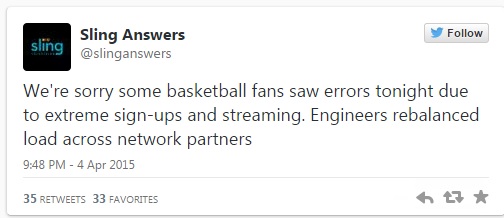With every webpage loaded, email sent, or video streamed, network traffic takes a complex journey…
A teachable moment from March Madness
Peter Kafka of re/Code penned an article on what happened when lots of subscribers logged on at the same time to watch the final four matchups on Sling TV this past weekend. You can see the entire article here.
Peter mentions he tuned into a different streaming service via Turner’s “March Madness” app to see the 2nd half of the Wisconsin game – commenting “it worked just fine – except in the last couple minutes when it shut down twice, sending me into convulsions.” In this case, Sling owned up to the issue and did something about it. In Peter’s case – he might just have had luck on his side.

What does any of this have to do with migrating to SaaS applications like Box, Office 365, Salesforce.com or Workday?
If your organization is like most – you rely on an increasing number of these shared web based application services to run your business.
Imagine the impact on your business in your 2 minute warning at the end of a quarter? What kind of convulsions would your Chief Sales Officer experience when quotes can’t be created in SalesForce.com or delivered by Exchange Online? How about your Chief People Officer having employees miss the deadline for open enrollment due to performance issues with Workday? Or manufacturing delays caused by an inability of Production engineers to access the latest Design specs on Box.net?
Migrating to these applications was supposed to spare the IT organization from having to manage these services, right?
Peter goes on to say “Even when operators like Sling aren’t at fault, something else down the line – your local broadband provider, your router, or your own operator error – can prevent you from watching what you want, when you want”
Globally distributed SaaS apps require globally distributed monitoring
So if your business critical SaaS application is experiencing issues – what’s your plan when the provider say it’s not their problem – it must be you? What’s your strategy to assure it’s not your own network routers and switches, DNS, proxy and firewalls? What are you doing to assure when all of that is working fine, it’s not your ISP – or something between them and your SaaS provider’s datacenter?
Fortunately – there is something you can do. You can proactively monitor the end to end health of all of your SaaS services with CloudReady Monitor. CloudReady automatically compares performance from your locations with 1000s of data points from other subscribers – “The Crowd”. If the problem is “them” – the Crowd will tell you that instantly. If the problem lies elsewhere – CloudReady will help you pinpoint exactly where the problem lies – continuously tracing every hop between your users and the provider.
SaaS Madness
Just about every organization has their equivalent of March Madness: those times when many users are logging in to get some critical work done on deadline. When the applications (or pieces of them) are hosted in the Cloud with a SaaS provider – IT is still on the hook to assure users can get that work done. If you want to spare you and your users the kind of “convulsions” Peter experienced in those final minutes of Wisconsin-Kentucky – take a look at CloudReady Monitor – or try it for free.


